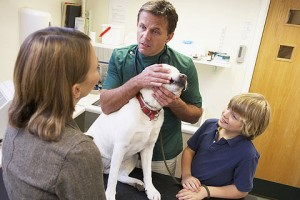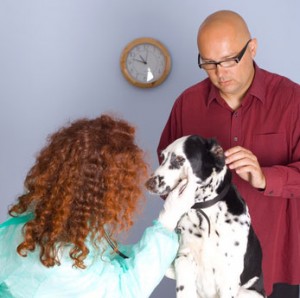
Preparing to Visit the Vet
Posted by admin on April 24, 2014
Although it would be nice if your vet could immediately spot potential problems with your dog during his or her annual check-up, the fact of the matter is that 15 minutes a year is not enough for the vet to see changes that could indicate an illness. As your dog’s guardian, you have a responsibility to spend enough time with your dog to give the vet sufficient information to keep the animal healthy.
Be Your Dog’s Advocate
In her book Speaking for Spot Dr. Nancy Kay, a veterinarian from California, proposes the ten commandments of veterinary office visits:
- Thou shalt push thy veterinarian off her pedestal.
- Thou shalt be present
- Thou shalt let the staff know if thy dog is aggressive.
- Thou shalt provide information
- Thou shalt confess everything.
- Thou shalt pause for confusion.
- Thou shalt share thy concerns.
- Thou shalt ask questions.
- Thou shalt treat the entire staff well.
- Thou shalt always come away with a plan.
By following these ten steps, you improve the chances that you and your vet will be able to determine the best course of action for whatever is bothering your dog.
Observe Your Dog Often
Whether it’s at bath time, play time, or while the dog is asleep, be sure to make a conscious effort at observing your dog. One of the biggest clues to an illness of any kind is a change in the dog’s behavior or habits. Since your dog can’t verbalize his or her pain, you must be an observant detective to discover what’s wrong.
Some things are fairly obvious, such as a muscle strain causing the dog to begin limping. However, other changes are more subtle. For example, a dog who is having mouth pain may eat more slowly than usual. A dog who has bronchitis may breathe more noisily. Or a dog who has always been scared of loud noises but slept through last night’s thunderstorm may have an ear infection that is impairing his or her hearing.
When you make an appointment to visit the vet, be sure to mention these changes in your dog’s habits because the vet will not be able to watch your dog eat or sleep, and he or she can’t see how the dog reacts to a thunderstorm if it isn’t storming during the visit.

Just like us, your can get sick or have a tooth ache. Make an effort to know how your dog behaves when he feels good so you can tell when he feels sick.
Early Cancer Detection
Because cancer is so much easier to treat in its early stages, one of the most important things you can do for your dog is a monthly screening for the disease. The top ten symptoms of cancer are listed below.
- An unusual lump or swelling.
- A sore that won’t heal.
- Unexplained weight loss.
- Loss of appetite.
- Bleeding or discharge from a body opening.
- Offensive odors that are new or unusual.
- Difficulty eating or swallowing.
- Change in activity level.
- Lameness or stiffness.
- Change in normal biological functions such as breathing or eliminating waste.
If you see these symptoms, particularly if more than one is present, you will want to see your vet sooner rather than later. Working together, you and your veterinarian can assure your dog’s best health for many years to come.


